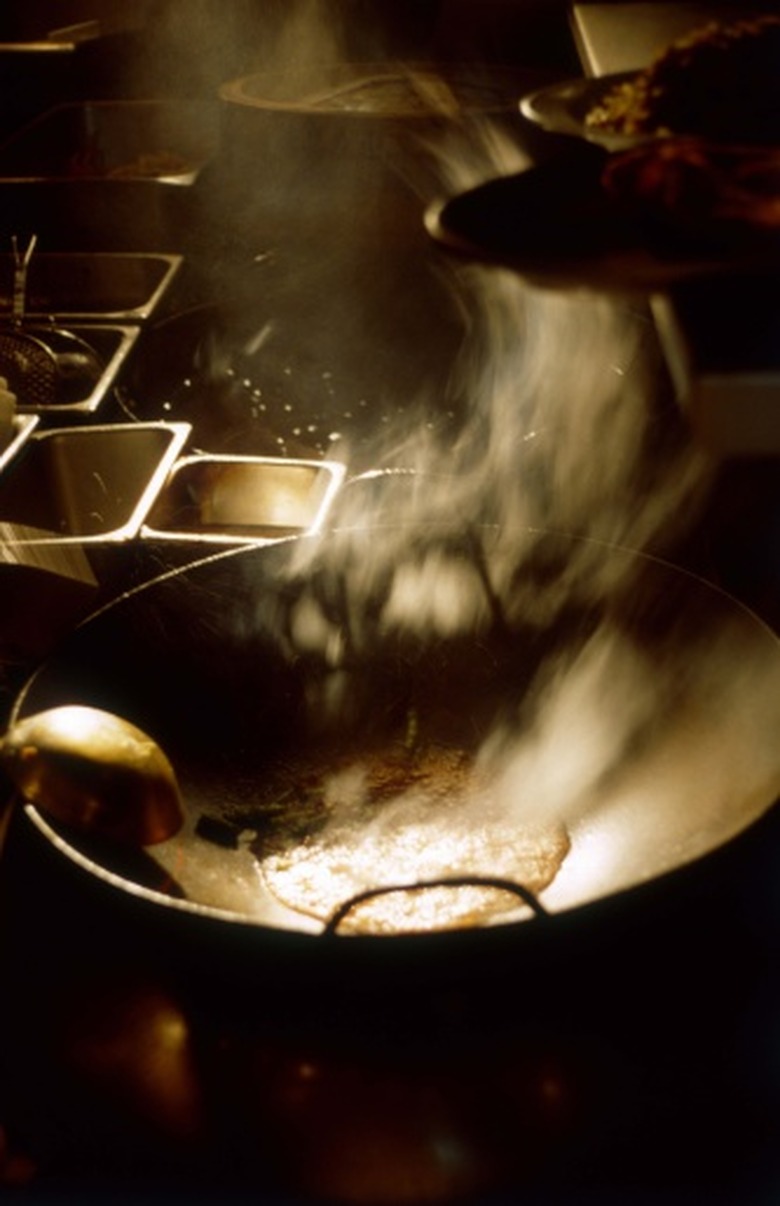How To Rationalize The Difference In Boiling Points
You may have noticed that different substances have widely varying boiling points. Ethanol, for example, boils at a lower temperature than water. Propane is a hydrocarbon and a gas, while gasoline, a mixture of hydrocarbons, is a liquid at the same temperature. You can rationalize or explain these differences by thinking about the structure of each molecule. In the process, you'll gain some new insights into everyday chemistry.
Step 1
Think about what holds together the molecules in a solid or a liquid. They all have energy — in a solid, they're vibrating or oscillating and in a liquid they're moving around each other. So why don't they just fly apart like the molecules in a gas? It's not just because they experience pressure from the surrounding air. Clearly, intermolecular forces are holding them together.
Step 2
Remember that when molecules in a liquid break free of the forces holding them together and escape, they form a gas. But you also know that overcoming those intermolecular forces takes energy. Consequently, the more kinetic energy molecules in that liquid have — the higher the temperature, in other words — the more of them can escape and the faster the liquid will evaporate.
As you keep on raising the temperature, you'll eventually reach a point where bubbles of vapor start to form beneath the surface of the liquid; in other words, it starts to boil. The stronger the intermolecular forces in the liquid, the more heat it takes, and the higher the boiling point.
Step 3
Remember that all molecules experience a weak intermolecular attraction called the London dispersion force. Bigger molecules experience stronger London dispersion forces, and rod-shaped molecules experience stronger London dispersion forces than spherical molecules. Propane (C3H8), for example, is a gas at room temperature, while hexane (C6H14) is a liquid — both are made of carbon and hydrogen, but hexane is a bigger molecule and experiences stronger London dispersion forces.
Step 4
Remember that some molecules are polar, meaning they have a partial negative charge in one region and a partial positive charge in another. These molecules are weakly attracted to each other, and this kind of attraction is a little stronger than the London dispersion force. If all else remains equal, a more polar molecule will have a higher boiling point than a more nonpolar one. o-dichlorobenzene, for example, is polar while p-dichlorobenzene, which has the same number of chlorine, carbon and hydrogen atoms, is nonpolar. Consequently, o-dichlorobenzene has a boiling point of 180 degrees Celsius, while p-dichlorobenzene boils at 174 degrees Celsius.
Step 5
Remember that molecules in which hydrogen is attached to nitrogen, fluorine or oxygen can form interactions called hydrogen bonds. Hydrogen bonds are much stronger than London dispersion forces or attraction between polar molecules; where they are present, they dominate and elevate the boiling point substantially.
Take water for example. Water is a very small molecule, so its London forces are weak. Because each water molecule can form two hydrogen bonds, however, water has a relatively high boiling point of 100 degrees Celsius. Ethanol is a bigger molecule than water and experiences stronger London dispersion forces; since it has only one hydrogen atom available for hydrogen bonding, however, it forms fewer hydrogen bonds. The larger London forces are not enough to make up the difference, and ethanol has a lower boiling point than water.
Step 6
Recall that an ion has a positive or negative charge, so it's attracted towards ions with an opposite charge. The attraction between two ions with opposite charges is very strong — much stronger in fact than hydrogen bonding. It's these ion-ion attractions that hold salt crystals together. You've probably never tried to boil salt water, which is a good thing because salt boils at over 1,400 degrees Celsius.
Step 7
Rank the interionic and intermolecular forces in order of strength, as follows:
IIon-ion (attractions between ions) Hydrogen bonding Ion-dipole (an ion attracted to a polar molecule) Dipole-dipole (two polar molecules attracted to each other) London dispersion force
Note that the strength of the forces between molecules in a liquid or a solid is the sum of the different interactions they experience.
References
- "Chemical Principles: The Quest for Insight"; Peter Atkins, et al.; 2008
- "Organic Chemistry, Structure and Function"; Peter Vollhardt, et al.; 2011
Cite This Article
MLA
Brennan, John. "How To Rationalize The Difference In Boiling Points" sciencing.com, https://www.sciencing.com/rationalize-difference-boiling-points-8394928/. 24 April 2017.
APA
Brennan, John. (2017, April 24). How To Rationalize The Difference In Boiling Points. sciencing.com. Retrieved from https://www.sciencing.com/rationalize-difference-boiling-points-8394928/
Chicago
Brennan, John. How To Rationalize The Difference In Boiling Points last modified March 24, 2022. https://www.sciencing.com/rationalize-difference-boiling-points-8394928/
